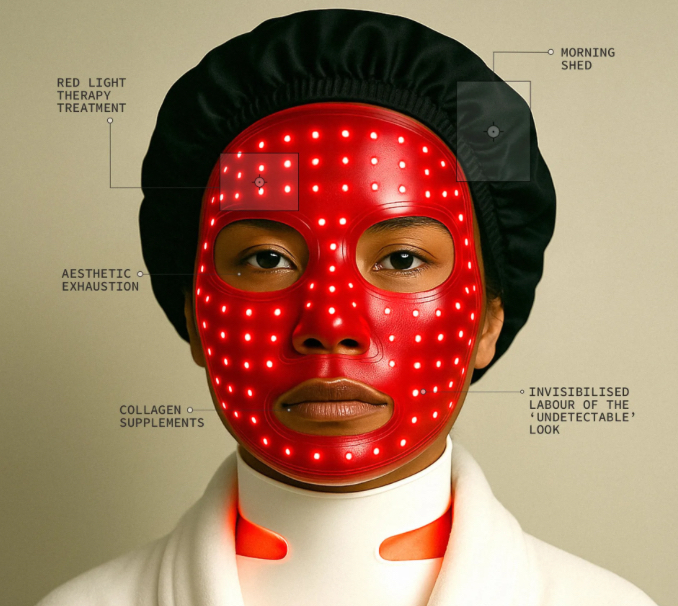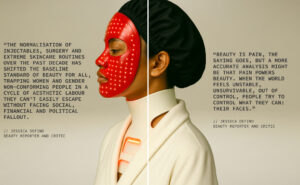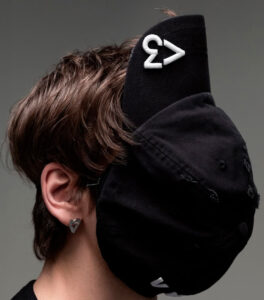That’s the starting point. The truth you feel in your skin before you even roll out of bed. Because before the day begins, your face has already been working—under tape, serum, pressure, and expectations.
The reigning aesthetic doctrine? High maintenance to be low maintenance. The paradox at the heart of modern beauty is that to look like you woke up like this, you actually have to wake up earlier than everyone else. You have to schedule your downtime around your upkeep. You have to buy time, lease energy, and hack your face into soft submission.
It’s not just vanity. It’s labor. And it’s constant.
Welcome to the morning shed, where faces emerge from a cocoon of carefully calibrated treatments. Peel-off lip stains. Collagen-rich eye masks. Heatless curlers wrapped like soft restraints. Mouth tape to reduce facial sag. Face tape to hold structure. By the time you see someone at 9 a.m., their face has already lived through a full routine—and discarded the physical evidence like wrappers from a late-night binge.
It’s not a mess. It’s maintenance. And it’s a performance.
The Rise of “Effortful Minimalism”
This era of “effortless beauty” is perhaps the most effort-heavy beauty culture in modern history. From semi-permanent tattooing of brows and lips to weekly LED therapy, from at-home microcurrent tools to injectables sold as wellness boosters, the goal is simple: make the work disappear.
You shouldn’t look like you’ve had anything done. That would ruin the illusion. Instead, your face must remain in a permanent state of post-vacation glow—well-rested, naturally snatched, glassy but not greasy.
And that takes work. It takes money. It takes time. It takes discipline.
Ironically, this pursuit of “natural” beauty has never been more manufactured. We’re contouring skin that’s already been sculpted by filler. We’re applying mascara to lashes that have been tinted and lifted. We’re exfoliating faces that were chemically resurfaced days ago.
And it all falls under the aesthetic umbrella of “clean.” Clean girl. Soft girl. Quiet luxury. All of it coded. All of it loaded.
The Body as a Project
In this version of beauty, your face is your job. Your body is your startup. And your time? That’s your budget. The more discreet the results, the higher the cost. Because true luxury in 2025 isn’t looking expensive—it’s looking unbothered.
This is the logic of the beauty economy now: effort equals value, but only if that effort is invisible. If people can see you trying, you’re doing it wrong. The work must disappear behind the results. You can share the glow, not the grind.
This isn’t just about skincare. It’s about identity. Surveillance. Power.
Beauty has always been a marker of status. But in the current moment, it’s a constant balancing act between appearing natural and being chemically optimized. And the tension is exhausting. You’re supposed to age, but gracefully. You’re expected to look young, but not plastic. You can have work done, but not talk about it. Unless you’re talking about it as empowerment. But not too much. That’s cringe.
The body becomes a battleground for contradictions—and every day is a negotiation.
The Morning Shed: Ritual or Refuse?
It’s not just the labor of application anymore. It’s the discarding that defines modern beauty. The “morning shed” has become its own performance—documented in TikTok GRWM videos and “unready with me” tutorials.
Peeling off a sheet mask. Unwrapping heatless curlers. Removing face tape. Tossing under-eye patches. It’s an aesthetic of aftermath, the visual proof that care has been taken, even if the results are meant to look casual.
Beauty has become a cycle of wear and discard. And it raises the question: is this self-care, or is it just another form of consumption?
Because behind every minimalist makeup look is a maximalist drawer of tools, tech, and products. The counter might be clean, but the trash bin is full. Of packaging. Of waste. Of the very effort we’re pretending wasn’t there.
How We Got Here: The Post-Pandemic Face
In the wake of the COVID-19 pandemic, beauty underwent a reset. People stopped wearing full glam. Offices went remote. Zoom calls framed the face differently. The rise of skincare culture replaced the need for contour palettes.
But that “low-maintenance” shift was misleading. Instead of dialing back, the beauty industry evolved. It found new ways to offer control and comfort—through serums, treatments, devices. Minimalism didn’t mean less. It meant more things doing less-visible work.
Post-pandemic, the skin barrier became the new battlefield. The face was no longer just a surface—it was a site of repair. That language—“barrier support,” “skin cycling,” “dermal health”—was clinical. Technical. It felt like self-improvement, not vanity. But it was still aesthetic labor. Just repackaged.
And when life returned to public spaces, that quiet labor stuck around. It followed us out of lockdown, now backed by a new wave of tools and treatments promising effortless perfection.
The Masculinization of Maintenance
One major shift in the Future of Appearance is how these rituals are spreading across gender lines. The beauty burden was once squarely on women. But now, male beauty is booming—and not just in grooming.
Men are freezing fat, brightening under-eyes, tinting lashes, microneedling, and yes, taping their faces. Quietly. Discreetly. But definitely.
Products are unisex. Language is neutral. The marketing is subtle: “performance skincare,” “stress-reducing facials,” “longevity treatments.” But the routines? They mirror the same logic: spend more to look like you spent nothing.
It’s not about feminizing masculinity. It’s about corporatizing vanity. The face is a brand, and everyone’s trying to stay on-message.
Future Forward: What Beauty Might Look Like in 2045
Project this trend 20 years forward, and the future of beauty may not be radically different—but it will be radically embedded. We’re heading toward integrated aesthetics, where the distinction between natural and artificial no longer matters because the enhancements are designed to be permanent, undetectable, or internal.
- Subdermal tech: Microchips that monitor hydration, inflammation, and hormone levels, adjusting serums via smart delivery systems under the skin.
- DNA-customized products: Personalized topicals and ingestibles based on genetic analysis that “optimize” your skin’s potential.
- Neurocosmetics: Skincare with mood-regulating effects, affecting serotonin and cortisol levels.
- Programmable hair and nails: Bioengineered cells that grow into predetermined colors and textures.
- Behavioral training masks: Overnight devices that train facial muscles during sleep for optimal contouring.
The end goal? To blur the line between biology and design. To turn beauty from a behavior into an operating system.
Resistance: Opting Out as Aesthetic
Of course, with every trend comes backlash. Already, we’re seeing subcultures forming around beauty refusal—“skin neutrality,” “face idleness,” “bareface liberation.” These aren’t trends in the commercial sense. They’re quiet rejections.
Some influencers are ditching skincare altogether. Others are documenting acne, aging, and asymmetry without edits. For them, the point isn’t to look bad—it’s to be free from the pressure to look better.
And maybe that’s the final frontier of beauty: doing less and meaning it.
But even that can be aestheticized. Even that, in the right filter, becomes content.
In 2025, to be beautiful is to be tired.
Not because beauty is inherently exhausting, but because the performance of beauty never ends. It’s not just about looking good—it’s about looking effortless while performing a full-time job of self-curation. It’s maintenance disguised as minimalism. It’s buying serenity, applying it in 12 steps, and discarding the evidence before anyone sees the scaffolding.
The future of appearance isn’t just what we’ll look like. It’s how much we’ll tolerate to look like that.
No comments yet.









